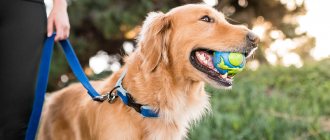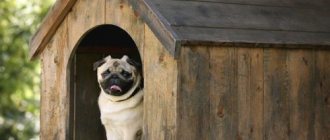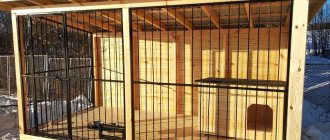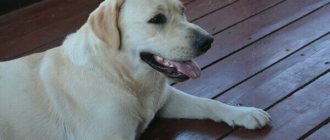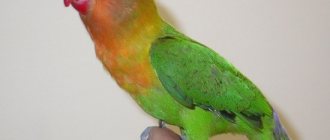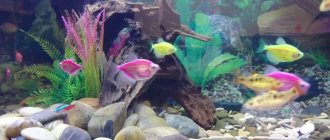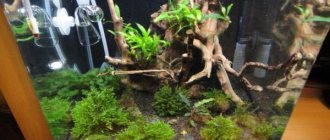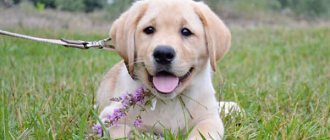Labrador (the name is similar to the Portuguese “trabalhador” - worker) belongs to the elite breeds.
Its representatives are superior to most service and user dogs in terms of sense of smell, swimming ability, and memory capacity.
A high level of intelligence allows the Labrador to feel equal to any owner, although he prefers capable companions.
Psychologically, a dog from birth is determined to create and maintain partnerships with its owner.
Labrador is ready to understand a person at a glance - as long as he is able to clearly explain his requirements.
The dog knows how to adapt to a change of environment, in any conditions it feels proud and confident.
Labrador is an optimist and a healthy guy with a positive attitude.
The kind attitude of others is the norm for him; he himself treats them the same way. The dog tries to please the wishes of the owner.
There are several ways to train your Labrador to use the toilet outside.
Which one to choose depends on the age of the purchased puppy, its living conditions in the first days, the time of year, and the owner’s character traits.
How to understand that a pug wants to go to the toilet?
But how can you understand that a dog wants to go to the toilet if it doesn’t ask to go for a walk? ... If the dog does not ask to go outside, you should pay attention to the following signs:
- the pet is worried and cannot find a place for itself;
- actively sniffs the surrounding area;
- spins in one place;
- moves quickly from one corner to another.
Interesting materials:
How to share videos from Google Drive? How to prepare bean seeds for planting? How to prepare to meet your parents? How to feed starter in the refrigerator? How to starch tulle? How to increase FPS in CS GO on a weak laptop? How to increase Stories views on Instagram? How does the dough rise? How to choose a tie for a gray suit? How to choose shoes to match a jacket?
Puppy and hygiene in the house
Cleanliness is an innate quality of any dog; Labrador is the rule rather than the exception.
If a three-week-old puppy, a fool, gets into the house, at first he will dirty the floors.
The frequency of incidents will reach five to seven per day.
It is unlikely that by this age the dog will have developed any stable behavioral skills.
It is still too early to take a puppy outside every time at this age: he simply will not “carry” all the “wealth” to the nearest garden bed.
One thing is clear: as soon as the baby learns to move a distance of 5–6 meters, he will tend to defecate outside the “den.”
Experts advise spreading several diapers or newspapers that absorb moisture at this distance from the puppy’s mat.
The need for a baby Labrador occurs after sleep, after eating and during play.
At first, the dog does everything very quickly and without prior preparation.
Therefore, breeders initially recommend that the puppy be moved to the toilet area five to fifteen minutes after waking up and finishing feeding.
It is better to fence off the dog’s habitat during this time.
If the puppy manages to poop somewhere in the middle of the room during play, he should not be punished: the puddle is wiped off with a newspaper and taken to the permanent toilet.
There the wet litter is hidden under the dry one. The crime scene is treated with a weak solution of vinegar, potassium permanganate or deodorant.
Photo gallery
We hope you find this article useful. And now you, without much difficulty, will find mutual understanding with your little pet on this sensitive issue.
Do I need to get vaccinated?
At 3 months, the puppy receives a mandatory vaccination against canine distemper, infectious hepatitis, parvovirus enteritis and canine parainfluenza: Nobivac DHPPi + Nobivac Lepto or Eurican DHPPI2-L.
10 days before vaccination, treatment against worms is required, and after vaccination the animal must be quarantined for 14 days.
Labrador - description of the breed
Labradors are medium in size, strong and fairly developed muscles. The head is also of medium size and quite wide. The muzzle is trapezoidal, the eyes are brown and round. The nose is usually brown or black, depending on the coat color. The ears are always drooping and triangular in shape.
Coat color can be of three types: brown, yellow, black. Some individuals have a small white spot on the chest. These dogs do not know how to deny themselves food. They will eat as much as their owner gives them, even if they are no longer hungry. For this reason, they can easily be overfed and become obese. Obesity is not only unsightly, but also leads to serious heart disease.
The normal weight of a Labrador is:
- 30-36 kg for males;
- 25-32 kg for females.
Fun fact: Labradors are energetic animals. It is important for them to create constant activity. Dogs should run and do various exercises for at least thirty minutes a day. And better - more!
The height of an adult can reach fifty-seven centimeters (at the withers). Due to their physical parameters, such dogs began to be used in search and rescue operations, in various shows, to search for explosives and narcotic substances. Labradors are also the main assistants for the disabled.
A distinctive feature of the breed is its coat. It is thick, warm, shiny. The dogs are short-haired; there are no fringes or waves on their body. Labradors also have a waterproof undercoat. It is distinguished by its high density. This makes the animals excellent swimmers.
Answer
By nature, the Labrador is not intended to live in a city apartment. Nature has created an impatient breed. Canine instincts allow the dog to send physiological needs immediately when a desire arises.
Of course, the owners are not happy with this state of affairs. Punishments begin in the form of poking one's nose into a puddle or pile. The trouble is that the puppy comes to completely different conclusions. Fearing punishment, the animal begins to eat the parcels in order to hide traces of the crime.
Basic feeding rules
Labradors quickly get used to the schedule set by the owner, so they need to be fed at the same time, leaving the bowl of food for 15 minutes. If the pet does not eat or begins to play, the food is removed. This is how you teach your dog to be disciplined.
You shouldn’t walk around with a bowl and try to persuade someone to eat . Otherwise, you will have to beg an adult dog later. Access to fresh water should be available at all times.
A puppy needs 2-4 times more nutrients than an adult dog of the same size, since the growth process is accompanied by high energy costs .
Three-month-old dogs eat a large amount of food in relation to their total body weight, but their stomachs are still small and can only accommodate frequent small portions.
Lifespan
So how long do Labradors live? Statistics show that the average life expectancy of dogs of this breed is 10-12 years, which is the average for dogs. For comparison: bulldogs live 8-10 years, pugs - 12-15 years, huskies and German shepherds - up to 15 years. French lap dogs show the maximum average life expectancy of 17.5 years.
The record for longevity among dogs, according to Wikipedia, still belongs to Labradors: the dog Chilla from Australia lived to be 32 years old, which by human standards is equivalent to 150 years.
Difficulties of adolescence
At three months the baby can be walked. A “walk” is not a “walk” where the puppy should frolic and play.
Walking is a targeted event; this understanding must be conveyed to the dog.
The exit schedule should remain the same as in early childhood: after waking up, ten minutes after eating, before bedtime.
It turns out that you need to make up to seven trips outside per day - for this you need to set aside an hour and a half of time.
In contrast to mischievous walks, walk the dog at a slow pace, giving it the opportunity to sniff those objects that it deems necessary.
At the same time, it is not out of place to say words that he remembered once, those that will prompt the baby to perform the necessary action.
You can take scraps of newspapers and household toiletries with you to place them in the right places.
A walk should end with a walk. After running around and playing with other dogs, the puppy is led on a leash to a familiar place and walked on a long leash.
The dog may simply get carried away and not remember the need to do important things.
Best Pillar Toilets for Dogs
For male dogs who mark their territory, manufacturers offer toilets with poles. They look like an ordinary plastic pyramid, sometimes stylized as street fire hydrants or stumps.
Shurum-burum
4.8
★★★★★
editorial assessment
90%
buyers recommend this product
The corner tray with a post, with its dimensions of 48x34 cm, is suitable for small dogs. The 14cm walls protect the walls from splashes and faeces.
The removable post can be installed anywhere in the tray. Durable plastic is easy to clean under running water. Also, for ease of cleaning, you can put a diaper in the tray and secure it with frames.
Pros:
- high sides;
- big size;
- easy to clean;
- the column can be rearranged.
Minuses:
- high price (from 1500 rubles);
- The manufacturer does not monitor the packaging.
When purchasing, you need to check the contents of the product. Sometimes the tray comes without a post or grid.
Adult dog diet
Nutrition and care for your Labrador are very important. An adult dog is fed either natural food or ready-made dry food. Two meals a day are expected at certain times, since discipline is very important for representatives of the breed.
Animals are very energetic, so they should be provided with a sufficient amount of protein food to be active. The diet includes offal, as well as greens and boiled vegetables.
It is very important to feed your dog properly
Booth
The main building inside the enclosure is a doghouse. While inside the kennel, the dog should be able to stand upright and lie down with its paws extended. Therefore, its height and depth should be equal to the dog’s height plus 10-15 cm. If the size of the booth is smaller or larger than recommended, the Labrador in the first case is at risk of diseases of the bones and joints, in the second it will be difficult for him to stay warm in the winter.
Materials for the kennel should be natural, most often it is deciduous wood, because... Coniferous wood produces a sticky resin with a pronounced odor. The boards must be treated with a compound against fungus and rot. The paint covering the booth must be water-based. The roof can be of any shape, and for cleaning and disinfection inside it must be completely removed or folded down.
Labrador retrievers are a breed not adapted to severe frosts. If a Labrador lives in a kennel in winter, the owners need to take care that the animal does not freeze in winter. It is better to make a booth with double walls. Between them it is necessary to lay insulation - sawdust or polystyrene foam.
